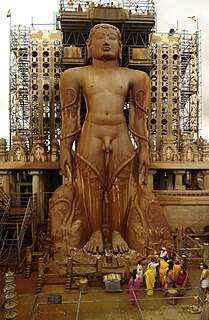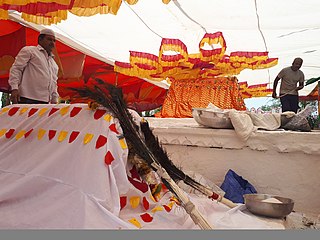
The Krishna River is the fourth-biggest river in terms of water inflows and river basin area in India, after the Ganga, Godavari and Brahmaputra. The river is almost 1,288 kilometres (800 mi) long. The river is also called Krishnaveni. It is one of the major sources of irrigation for Maharashtra, Karnataka, Telangana and Andhra Pradesh.

The Tungabhadra River is a river in India that starts and flows through the state of Karnataka during most of its course, before flowing along the border between Telangana, Andhra Pradesh and ultimately joining the Krishna River near Gundimalla village in Jogulamba Gadwal district of Telangana.

Bagalkote district, is an administrative district in the Indian state of Karnataka. The district headquarters is located in the town of Bagalkote. The district is located in northern Karnataka and borders Belagavi, Gadag, Koppal, Raichur and Vijayapura. The new Bagalkote district was carved out of Vijayapura in 1997 via Government of Karnataka directive Notification RD 42 LRD 87 Part III. The bifurcated Bagalkote district consists of nine taluks — Badami, Bagalkote, Bilagi, Guledgudda, Rabkavi Banhatti, Hunagund, Ilkal, Jamakhandi and Mudhol.

Kolluru or Kollur is a small temple-town in Byndoor Taluk in Udupi district of Karnataka state, India. It is situated about 27 km from Byndoor town. This village lies at the foot of the Western Ghats and is famous for the Mookambika temple, a Hindu pilgrim center. The village is located on the banks of Agnitheertha and Souparnika river.

Khanapur is a panchayat town in Belgavi district, Karnataka, India. It is about 26 km from Belagavi. The town is governed by the Khanapur Municipal Council. Khanapur is the headquarters for Khanapur taluk. The town is on the Belgaum-Panaji National Highway, NH 4A. Khanapur is well connected by train and road to important cities in Karnataka, Goa, and Maharashtra. Kannada is the official language but Marathi is widely spoken in the town.

Karnataka, the sixth largest state in India, has been ranked as the third most popular state in the country for tourism in 2014. It is home to 507 of the 3600 centrally protected monuments in India, the largest number after Uttar Pradesh. The State Directorate of Archaeology and Museums protects an additional 752 monuments and another 25,000 monuments are yet to receive protection. Tourism centres on the ancient sculptured temples, modern cities, the hill ranges, forests and beaches. Broadly, tourism in Karnataka can be divided into four geographical regions: North Karnataka, the Hill Stations, Coastal Karnataka and South Karnataka.

Athani is a city in the Belagavi district of Karnataka, India. It is 140 kilometers from the city of Belagavi, 70 kilometers from Vijayapura, 55 kilometers from Miraj, 100 kilometers from Kolhapur, and 624 kilometers from Bengaluru.

Ainapur is a town in the southern state of Karnataka, India. It is located in the Athani taluk of Belgaum district in Karnataka. Ainapur village is famous for Peda, the village situated near river Krishna. Sugarcane is the chief cultivated crop and Kannada is the primary spoken language.

Darur is a village in the southern state of Karnataka, India. It is located in the Athani Taluk of Belagavi district in Karnataka.

Hulagabali is a village in the southern state of Karnataka, India. It is located in the Athani taluk toward north-east of Belgaum district. The basic occupation in Hulagabali is agriculture and there are also many landlords in the village who are famous in agriculture. Sugarcane is the highest percentage of agriculture as per the survey. There are quite a few temples in the village. The Birappa temple located in this village is well known in surrounding villages. Birappa temple has a large fair and festivities twice a year that draws huge crowd in the region. Sri Sangameshwara temple stands at the juncture of River Krishna and River Agrani. The famous landlords are Patil (Gouda).

Jugul is a village in the southern state of Karnataka, India. It is located in the Athani taluk of Belagavi district in Karnataka.

Kunnur is a village in the southern state of Karnataka, India. It is located in the Chikodi taluk of Belgaum district in Karnataka.

Mangasuli is a village located in Northern Karnataka, India. It is located in the Athani taluk of Belgaum district in Karnataka.

Saptasagar is a village in the southern state On River Bank of Krishna Karnataka, State India. It is located in the Athani taluk of Belgaum district in Karnataka.

Shedbal is a town in the southern state of Karnataka, India. It is located in the Athni taluk of Belagavi district in Karnataka. Shedbal is very close to Sangli Miraj twin cities.

Badachi is a village in Belgaum district in the southern state of Karnataka, India. It is located in Athani Taluka of Belgaum District, near Bijapur -Athani Highway. Maashahibi Darga is situated in the village managed by native Mulla(s) .Allabax S MULLA, Peeralal s mulla, Badashahlal d mulla and every year Maashahibi and Shakarbashah Uras is happen in April or may month,

Krishna-kittur is a village in the southern state of Karnataka, India. It is located in the Athani taluka of Belgaum district in Karnataka.
Mahishwadgi is a village in Belgaum district of Karnataka, India. Mahishwadgi is situated on the banks of Krishna River, 25 km from Athani, Belgavi. 90% of the population follow Jainism.
Teerth is a village in the Belgaum district of Karnataka, India. It is situated next to the Krishna River in Athani taluk.

Athani Taluk is the largest taluk in Belgaum District, Karnataka, India. It has a total area of 2,070.54 square kilometres (799.44 sq mi), of which 70% is cultivated. This includes 4 towns, 115 inhabited villages and hamlets with a rural population of 4,07,485, according to the 2011 census. The total population of the taluk is 5,25,832. It is bounded by Sangli District of Maharashtra in the north, Bijapur District in the east, and Bagalkot District in the southeast. Geologically the area is covered by Deccan Trap formations. The average annual rainfall is 582 millimetres (22.9 in). Two rivers flow through the taluk: the Krishna River and the Agrani.










